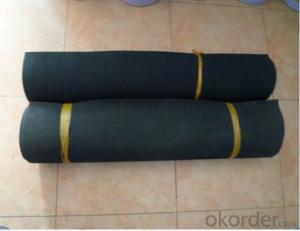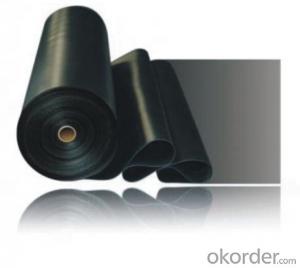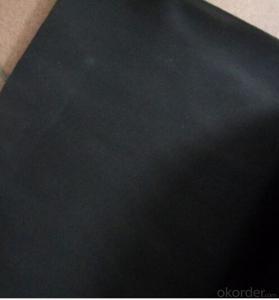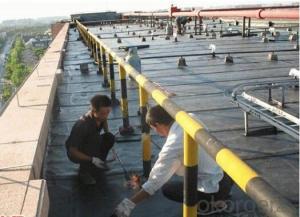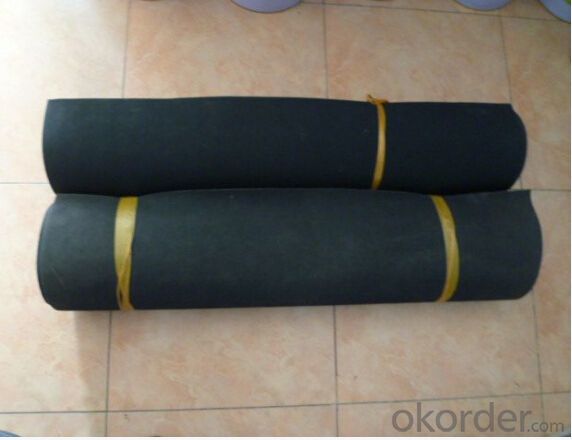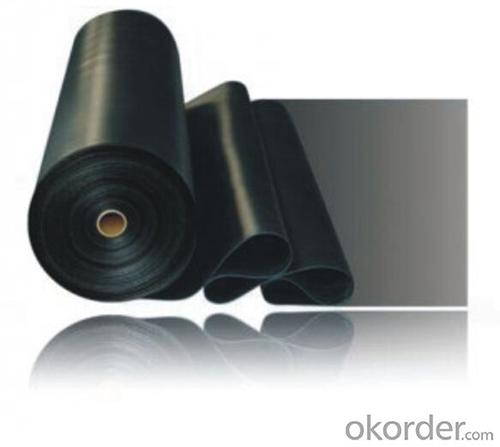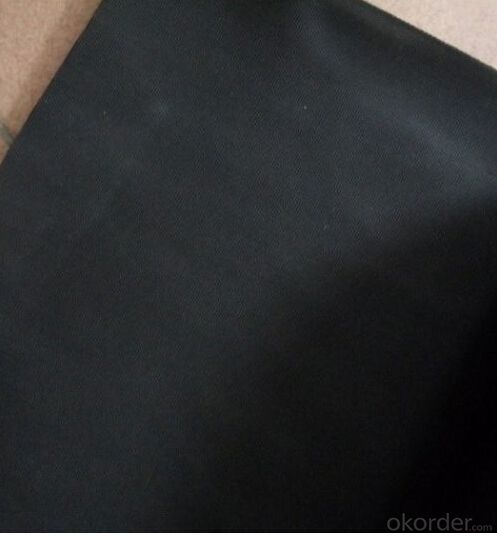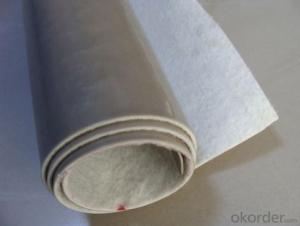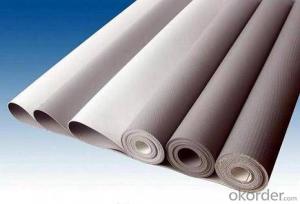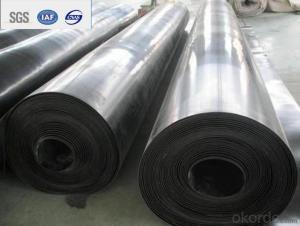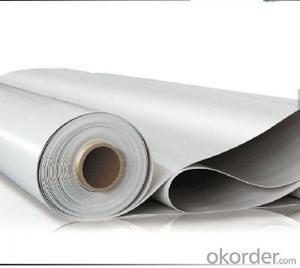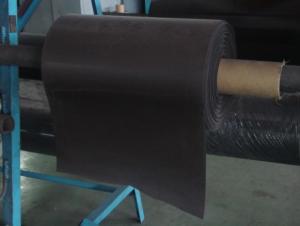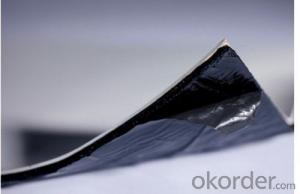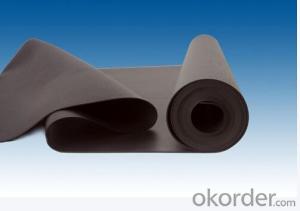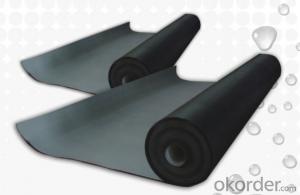EPDM Waterproofing Membrane 30mil/45mil Used for Roof Waterproofing
- Loading Port:
- Qingdao
- Payment Terms:
- TT or LC
- Min Order Qty:
- 2000 m²
- Supply Capability:
- 200000 m²/month
OKorder Service Pledge
OKorder Financial Service
You Might Also Like
1. Introduction of EPDM Waterproofing Membrane:
EPDM waterproof membrane is made from ternary ethylene-propylene rubber, which is designed for waterproofing of exposed and non-exposed applications. The product adopts the world-advanced equipment of cold feeding extrusion and continuous vulcanization technology.
EPDM waterproof membrane is of high elasticity among high polymer waterproof materials and becomes a world popular waterproofing material.
2. Specification of EPDM Waterproofing Membrane:
Type | EPDM Waterproof Membrane | ||
Material | EPDM Rubber | ||
Thickness | 1.2mm | 1.5mm | 2.0mm |
Weight(kg/m2) | 1.54-1.58 | 1.79-1.83 | 2.25-2.29 |
Size | 1.2m(width) * 20m(length)/roll | ||
Type | Vulcanized & Weldable | ||
Pattern | Non-reinforced(homogeneous) | ||
Packing | 24sqm/roll, with plastic bag | ||
Color | Black | ||
Application | Roof, basement, pond, Lake, steel structure roof, swimming pool, underground, tunnel, etc | ||
3. Application of EPDM Waterproofing Membrane:
(1) Roofs, Basement, Toilets
(2) Industrial and civil building waterproofing
(3) Geosynthetic liner for swimming pool, channels, irrigation system
(4) Especially suitable for projects with high requirements in durability, anti-corrosion and deformation
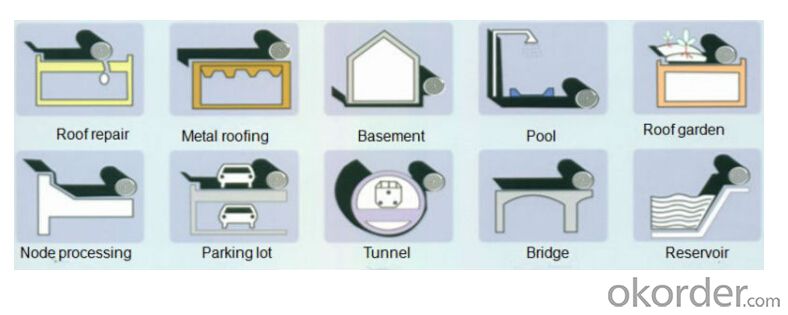
4. Some photos:
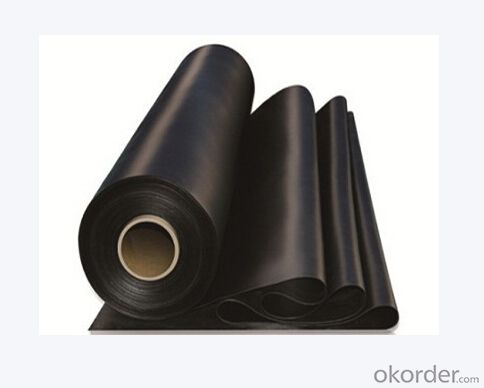
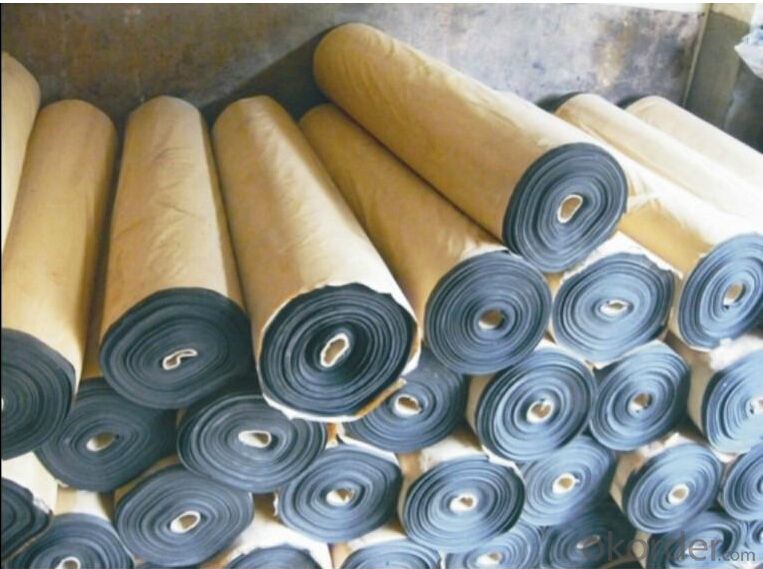
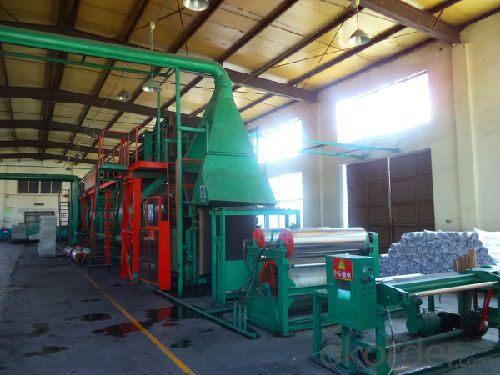
RFQ
1) what's your package?
One roll with one plastic bag, several rolls in one pallet
2) what's your payment terms?
T.T, L/C at sight is accepted
3) what's your delivery time?
Within one week against your payment received
- Q: Can waterproofing membranes be used on rooftop terraces?
- Yes, waterproofing membranes can indeed be used on rooftop terraces. In fact, they are often utilized to protect the structural integrity of the terrace and prevent water damage to the underlying structure. Rooftop terraces are exposed to various weather conditions, including rain, snow, and UV rays, which can lead to leaks and deterioration. Waterproofing membranes act as a barrier, preventing water from seeping through the surface and causing damage. These membranes are specifically designed for outdoor use and can withstand the harsh conditions typically found on rooftops. They are available in various materials such as modified bitumen, EPDM (ethylene propylene diene terpolymer), and PVC (polyvinyl chloride), allowing for flexibility in choosing the most suitable option for a specific terrace. Additionally, waterproofing membranes can be installed under various types of terrace finishes, including pavers, tiles, and decking, providing a versatile solution for different design preferences. Overall, the use of waterproofing membranes is highly recommended for rooftop terraces to ensure their longevity, durability, and resistance to water-related issues.
- Q: Can a waterproofing membrane be used for underground communication vaults?
- Yes, a waterproofing membrane can be used for underground communication vaults. Underground communication vaults are typically made of concrete or other materials that are susceptible to water infiltration. To prevent water damage and ensure the longevity of the vault, a waterproofing membrane can be applied to the exterior surface of the vault. This membrane acts as a barrier, preventing water from entering the vault and causing damage to the equipment or infrastructure inside. Additionally, the waterproofing membrane can also protect against other potential threats such as moisture, chemicals, and soil gases. It is important to choose a high-quality waterproofing membrane that is specifically designed for underground structures to ensure its effectiveness and long-term durability.
- Q: Can a waterproofing membrane be used on concrete bridges?
- Yes, a waterproofing membrane can be used on concrete bridges. Waterproofing membranes are commonly utilized in infrastructure projects, including concrete bridges, to protect the structure from water penetration and damage. These membranes create a barrier that prevents water from seeping into the concrete, thus enhancing the durability and longevity of the bridge.
- Q: Can waterproofing membranes be used on precast concrete panels?
- Yes, waterproofing membranes can be used on precast concrete panels. These membranes are designed to provide an effective barrier against water penetration, protecting the concrete from moisture damage. They can be applied directly to the surface of precast concrete panels, ensuring their long-term durability and preventing water-related issues such as cracking, spalling, or corrosion.
- Q: Can a waterproofing membrane be applied to existing structures or is it only suitable for new construction?
- A waterproofing membrane has the capability to be applied to both existing structures and new construction. These membranes are specifically designed to create a barrier against water infiltration, making them suitable for preventing water damage in various areas such as roofs, basements, and foundations. Whether it is an aged building or a recently constructed one, the application of a waterproofing membrane can effectively maintain the dryness of the structure and prevent problems associated with moisture, such as leaks, seepage, and mold growth. However, when applying a waterproofing membrane to an existing structure, it may be necessary to undertake additional preparation and surface treatment in order to ensure proper adhesion and efficiency. It is strongly advised to seek the guidance of an experienced waterproofing contractor who can evaluate the specific requirements of the structure and provide suitable solutions.
- Q: How does a waterproofing membrane handle exposure to chemicals?
- A waterproofing membrane is designed to provide protection against water and moisture, but its resistance to chemicals can vary depending on the specific type of membrane. Some waterproofing membranes are specifically formulated to withstand exposure to chemicals, while others may not be as resistant. Typically, a waterproofing membrane that is specifically designed to handle exposure to chemicals will have certain properties that make it more resistant. These properties may include a higher thickness, increased flexibility, and enhanced chemical resistance additives within the membrane. When a waterproofing membrane is exposed to chemicals, it should ideally be able to resist degradation, maintain its physical properties, and continue to provide effective waterproofing. However, it is important to consider that certain chemicals may still have an adverse effect on the membrane, especially if they are highly corrosive or reactive. To ensure the best performance in the face of chemical exposure, it is recommended to select a waterproofing membrane that is specifically designed to handle the types of chemicals it may come into contact with. It is also important to follow manufacturer guidelines for installation and maintenance to maximize the membrane's chemical resistance and overall lifespan. Regular inspections and maintenance are crucial to detect any signs of chemical damage or degradation on the waterproofing membrane. In cases where chemical exposure is expected to be significant, additional protective measures such as chemical-resistant coatings or overlays may be necessary to provide an extra layer of defense. In summary, the ability of a waterproofing membrane to handle exposure to chemicals depends on its specific formulation and design. Choosing a membrane with appropriate chemical resistance properties and implementing proper maintenance practices can help ensure its longevity and effectiveness in such environments.
- Q: Can a waterproofing membrane be used on precast aluminum surfaces?
- Indeed, precast aluminum surfaces can be effectively protected by utilizing a waterproofing membrane. These membranes are specifically engineered to safeguard various surfaces, encompassing concrete, metal, and other materials, against water infiltration. By acting as a formidable barrier, the membrane effectively thwarts the ingress of water into the precast aluminum surface. This proves to be especially advantageous in locales with elevated moisture exposure, such as surrounding swimming pools or outdoor environments. It is crucial to select a waterproofing membrane that is aluminum-compatible in order to guarantee optimal adhesion and long-lasting efficacy.
- Q: Are waterproofing membranes suitable for residential applications?
- Yes, waterproofing membranes are suitable for residential applications. They can effectively prevent water intrusion and protect homes from moisture damage, making them an ideal solution for basements, foundations, roofs, and other areas prone to water leakage.
- Q: Can a waterproofing membrane be used on below-grade walls?
- Indeed, a waterproofing membrane is capable of being employed on walls located below ground level. In fact, it is highly advisable to utilize a waterproofing membrane on such walls so as to shield them against infiltration of water and potential harm caused by moisture. Walls situated below ground level are especially susceptible to water penetration due to their proximity to the ground and the possibility of hydrostatic pressure. A waterproofing membrane serves as a protective barrier, effectively preventing water from seeping into the walls and leading to issues such as mold, mildew, decay, and structural impairment. Moreover, it aids in maintaining the interior of the edifice in a dry condition, thereby averting potential problems related to moisture.
- Q: What is called a waterproof roll dry shop, wet shop
- The biggest difference between the two is the same bonding strength, wet pad bonding strength is much larger than the dry shop method.
Send your message to us
EPDM Waterproofing Membrane 30mil/45mil Used for Roof Waterproofing
- Loading Port:
- Qingdao
- Payment Terms:
- TT or LC
- Min Order Qty:
- 2000 m²
- Supply Capability:
- 200000 m²/month
OKorder Service Pledge
OKorder Financial Service
Similar products
Hot products
Hot Searches
Related keywords
